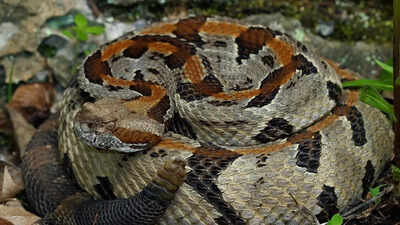ARTICLE AD BOX

A tragic incident at Savage Gulf State Park in Tennessee claimed the life of a hiker after a venomous timber rattlesnake bite. According to wildlife experts, the snake likely struck in self-defense when the hiker tried to pick it up, highlighting how dangerous even seemingly harmless interactions with wild snakes can be.
Timber rattlesnakes, Tennessee’s largest venomous species, typically avoid confrontation, preferring to stay still rather than bite. Experts warn that handling or provoking snakes significantly increases the risk of fatal bites. This incident underscores the importance of snake safety awareness, knowing first aid protocols, and exercising caution in snake-prone areas. Hikers are urged to avoid direct contact with wildlife to prevent similar tragedies.
Tennessee hiker bitten by venomous timber rattlesnake near 55th avenue trailhead
The hiker, whose identity has not yet been released, was exploring the area near the 55th Avenue trailhead in Gruelti-Laager, about 60 miles northwest of Chattanooga, on August 8, when the encounter occurred. According to Grundy County Emergency Management Director Matthew Griffith, witnesses observed the man pick up the snake, which promptly bit him on the hand.According to The New York Times report, emergency services arrived around 12:30 PM local time, administered CPR, and transported the victim to a nearby hospital.
Unfortunately, despite medical intervention, he later succumbed to the bite.
Timber rattlesnake: Tennessee’s largest venomous snake and its behaviour
Officials and wildlife experts identified the snake as a timber rattlesnake, the largest venomous snake species in Tennessee. These snakes typically measure three to five feet in length and are native to mature forests and rocky hillsides across the state.Although their size and appearance can be intimidating, timber rattlesnakes are generally docile and prefer to stay motionless rather than strike.
Experts emphasize that most bites happen when humans attempt to pick up or provoke the snake. In this case, the hiker’s action triggered the bite as a defensive response.
Understanding timber rattlesnake venom and allergic reactions
While the official cause of death has not been confirmed, authorities suspect the hiker may have suffered a severe allergic reaction to the snake’s venom.Dr. William Sutton, a herpetology expert at Tennessee State University, explained that timber rattlesnakes have hemotoxic venom, which primarily affects the victim’s blood and tissue.
While most individuals survive with prompt medical care, some can have extreme allergic reactions similar to anaphylaxis from bee stings. This can restrict breathing, lower blood pressure rapidly, and become life-threatening within minutes.
How common are fatal snake bites
According to CDC statistics, roughly 7,000 to 8,000 people are bitten by venomous snakes in the United States each year. Despite this, only about five fatalities occur annually.
Most bites result from attempts to catch, handle, or kill snakes, rather than accidental encounters.Griffith emphasised the importance of staying calm when encountering snakes, carrying basic first aid supplies, and seeking immediate medical attention if bitten.
Safety guidelines for hikers in snake habitats
To reduce the risk of snake bites, the CDC recommends the following precautions:
- Do not pick up snakes, even if they appear dead or docile.
- Remove rings or jewelry near bite areas to prevent complications from swelling.
- Clean the wound with soap and water.
- Cover the bite with a clean, dry dressing.
- Avoid ice, tourniquets, or venom extraction attempts.
- Seek immediate medical attention after a bite.
Implementing these measures significantly increases the chances of survival and reduces complications from venomous bites.Also Read | Rare purple Sirindhorn crab spotted in Thailand’s Kaeng Krachan National Park; Check pictures



.png)
.png)
.png)
















 10 hours ago
2
10 hours ago
2









 English (US) ·
English (US) ·